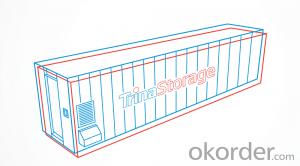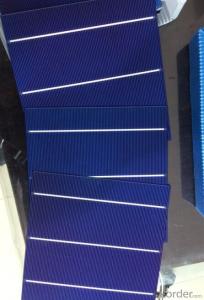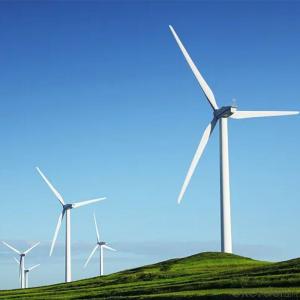Container energy power storage system battery pack solar energy
- Loading Port:
- Shanghai
- Payment Terms:
- TT OR LC
- Min Order Qty:
- 1 set
- Supply Capability:
- 10 set/month
OKorder Service Pledge
OKorder Financial Service
You Might Also Like
Item specifice

Container energy power storage system battery pack solar energy
Safety and reliable
● Optimized LFP route, strict cell safety test;
● Thermal simulation design of the whole process from PACK to container;
● Full range of electrical protection: high and low voltage separation, insulation monitoring, grounding protection, lightning protection design;
● Industrial grade temperature control system, to ensure the efficient and reliable operation of the system;
● Intelligent fire control, strategic linkage, multi-level protective measures.
Multidimensional integration
● Easy to transport, installation and operation;
● Easy to copy and expand modularized;
● Highly integrated battery module design to reduce internal resistance, improve consistency and energy efficiency;
●Intelligent local controller unified scheduling management in the box to improve the overall security and stability of the system.
Intelligence and Efficiency
● Large capacity, low internal resistance, long life of the cell design, improve the economy;
● High stability chip level BMS technology, improve battery SOC and available capacity accuracy;Cell level monitoring, improve the consistency and life of batteries;
● Full scene integrated EMS system architecture, high efficiency, digital, intelligent to ensure the reliability, stability and economy of energy storage and power supply;
● Fault prediction, fault identification and quick positioning.
| Item NO. | TSMG00002650 | TSMG00002660 | TSMG00002800 | TSMG00003100 |
| Battery specification | ||||
| Rated discharge rate | 1C | 0.5C | 0.5C | 0.25C |
| Battery cell | 3.2V/120AH | 3.2V/145Ah | 3.2V/120Ah | 3.2V/145Ah |
| Configuration | 1P216S | 2P24OS | 2P228S | 2P240S |
| Voltage range | 604.8-788.4V | 672-850V | 638.4-809.4V | 672-850V |
| Nominal capacity | 2.65MWh | 2.66MWh | 2.80MWh | 3.10MWh |
| Communication Interface | CAN,RS485,Ethernet | CAN,RS485,Ethernet | CAN,RS485,Ethernet | CAN,RS485,Ethernet |
| System specification | ||||
| Number of battery pack | 32 | 12 | 16 | 14 |
| IP | IP54 | IP54 | IP54 | IP54 |
| Size( L*W*H) | 13716mm*2438mm*2896mm | 12192mm*2438mm*2896mm | 12192mm*2438mm*2896mm | 12192mm*2438mm*2896mm |
| Weight(Include/exclude the battery) | 48.4T/8T | 38T/7T | 39T/7T | 38T/7T |
| Battery temperature control mode | Industrial grade temperature controlled air conditioning | Industrial grade temperature controlled air conditioning | Industrial grade temperature controlled air conditioning | Industrial grade temperature controlled air conditioning |
| Fire extinguishing system | HFC-227ea fire extinguishing system | HFC-227ea fire extinguishing system | HFC-227ea fire extinguishing system | HFC-227ea fire extinguishing system |
Images of Container energy power storage system

- Q:What is a monocrystalline Silicon Solar Cells?
- A monocrystalline Silicon Solar Cell is a kind of solar cell made of monocrystalline siclicon that has been used for many years. Because it is used in a way that is very unique in their use of a single, very pure crystal of silicon, It is considered to good for longevity.
- Q:Do solar cells require maintenance?
- Yes, solar cells require some maintenance. Regular inspections to check for any damage or debris on the panels, cleaning to ensure optimal sun exposure, and monitoring the performance of the cells are all necessary for proper maintenance.
- Q:What is the impact of solar cells on reducing energy inequality?
- Solar cells have a significant impact on reducing energy inequality by providing access to clean and affordable electricity for communities that are underserved or lack access to traditional power sources. By harnessing the abundant and renewable energy from the sun, solar cells facilitate the decentralization of energy production, enabling individuals and communities to generate their own power and reduce their dependence on centralized grids. This empowers marginalized communities to become energy self-sufficient, bridging the energy gap and promoting a more equitable distribution of energy resources. Additionally, solar cells contribute to mitigating climate change and reducing carbon emissions, which disproportionately affect vulnerable populations, further addressing energy inequality and promoting sustainable development.
- Q:Can solar cells be used for powering transportation infrastructure?
- Yes, solar cells can be used to power transportation infrastructure. Solar-powered electric vehicles (EVs) have become increasingly popular and accessible. Additionally, solar panels can be installed on charging stations, parking lots, and even along roads to generate electricity for EVs. Solar energy can also be used to power electric trains and trams, reducing their reliance on fossil fuels. Furthermore, solar cells can be employed to power street lights, traffic signals, and other transportation infrastructure, helping to reduce carbon emissions and promote sustainability.
- Q:Can solar cells be integrated into electric vehicle charging stations?
- Yes, solar cells can be integrated into electric vehicle charging stations. By harnessing solar energy, these charging stations can reduce reliance on the electrical grid and provide clean, renewable power for charging electric vehicles. This integration promotes sustainability and helps to reduce carbon emissions associated with transportation.
- Q:How do solar cells perform in areas with high levels of air pollutants?
- Solar cells generally perform less efficiently in areas with high levels of air pollutants. Air pollutants, such as smog, dust, and particulate matter, can accumulate on the surface of solar panels, reducing their ability to absorb sunlight. This buildup of pollutants creates a barrier between the sun and the solar cells, decreasing their overall performance and energy production. Additionally, air pollutants can also block and scatter sunlight, further diminishing the amount of sunlight reaching the solar cells. Therefore, in areas with high levels of air pollutants, regular cleaning and maintenance of solar panels are necessary to ensure optimal performance.
- Q:What is the difference between solar cells and solar panels?
- Solar cells and solar panels are both components used in harnessing solar energy, but they have distinct differences. A solar cell refers to a single unit that converts sunlight directly into electricity through the photovoltaic effect. On the other hand, a solar panel is composed of multiple interconnected solar cells and serves as a larger unit that generates a higher amount of electricity. In summary, solar cells are individual units, while solar panels are a collection of these cells working together to generate more power.
- Q:Can solar cells be used in powering medical devices?
- Yes, solar cells can be used in powering medical devices. Solar cells convert sunlight into electricity, which can then be used to power various medical devices such as portable diagnostic tools, wearable health monitors, or even small medical implants. This technology offers a sustainable and reliable energy source, particularly in areas with limited access to electricity or during emergencies where traditional power sources may not be available.
- Q:What is the solar cell?
- The type of solar cells can be divided according to the materials used: silicon solar cells, solar cells and organic semiconductor system of solar cells.
- Q:How do solar cells perform in high altitude locations?
- Solar cells generally perform better in high altitude locations compared to lower altitude areas. This is because higher altitudes often have less atmospheric interference, such as pollution and cloud cover, which can obstruct sunlight. Additionally, the thinner atmosphere at high altitudes allows for more direct and intense sunlight, resulting in increased solar energy generation. Overall, solar cells in high altitude locations can harness more sunlight and produce higher energy output.
1. Manufacturer Overview |
|
|---|---|
| Location | |
| Year Established | |
| Annual Output Value | |
| Main Markets | |
| Company Certifications | |
2. Manufacturer Certificates |
|
|---|---|
| a) Certification Name | |
| Range | |
| Reference | |
| Validity Period | |
3. Manufacturer Capability |
|
|---|---|
| a)Trade Capacity | |
| Nearest Port | |
| Export Percentage | |
| No.of Employees in Trade Department | |
| Language Spoken: | |
| b)Factory Information | |
| Factory Size: | |
| No. of Production Lines | |
| Contract Manufacturing | |
| Product Price Range | |
Send your message to us
Container energy power storage system battery pack solar energy
- Loading Port:
- Shanghai
- Payment Terms:
- TT OR LC
- Min Order Qty:
- 1 set
- Supply Capability:
- 10 set/month
OKorder Service Pledge
OKorder Financial Service
Similar products
New products
Hot products
Hot Searches
Related keywords
































